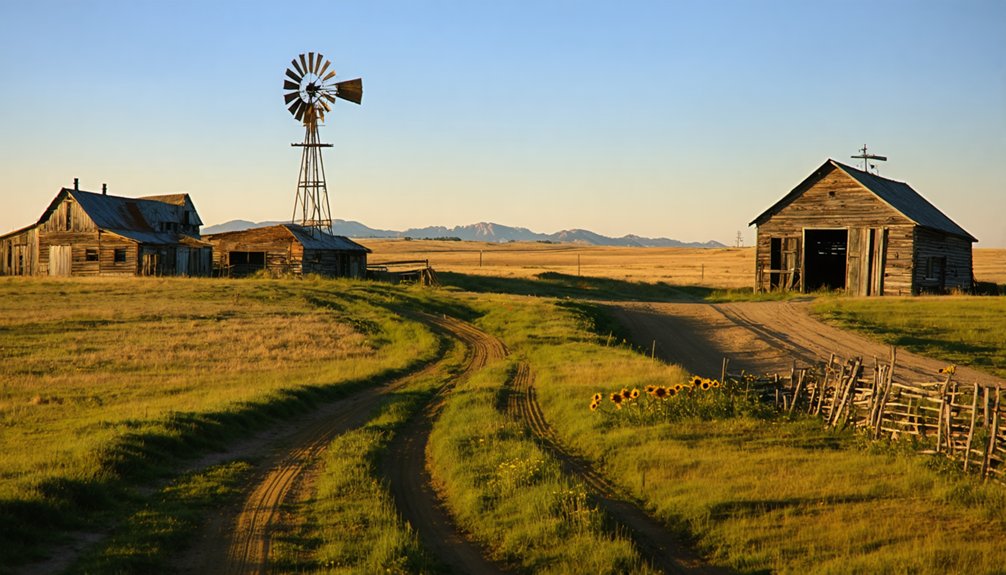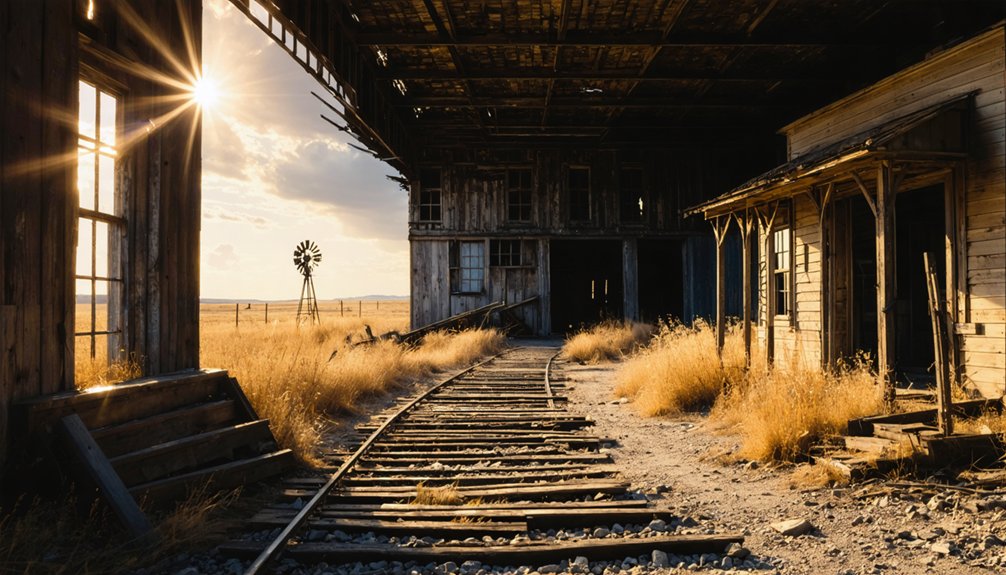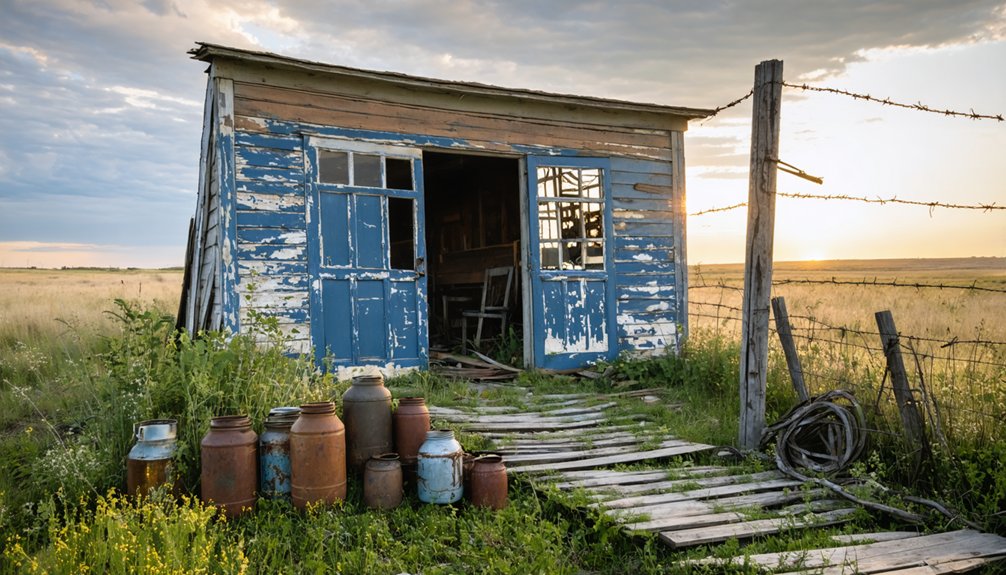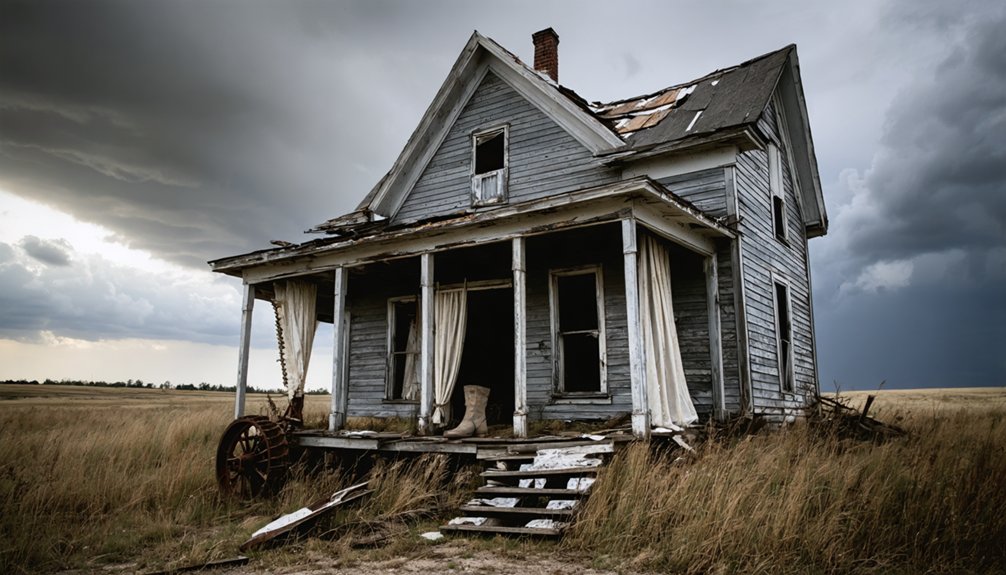You’ll find Dacy nestled in South Dakota’s Black Hills, a ghost town that emerged during the late 19th century railroad expansion. The settlement thrived briefly as a bustling hub with hotels, saloons, and two competing newspapers serving railroad workers and miners. By the mid-1900s, declining rail traffic and economic hardships of the Dirty Thirties led to its abandonment. Today, three scattered houses and deteriorating foundations offer glimpses into this once-vibrant frontier community’s past.
Key Takeaways
- Dacy was established in the late 19th century as a railroad town in South Dakota’s Black Hills region during westward expansion.
- The town’s economy centered around railroad operations, mining activities, and local agriculture before its eventual decline.
- Only three scattered houses and deteriorating foundations remain today, with no surviving commercial or civic buildings.
- Economic decline accelerated during the Dirty Thirties when railroad operations ceased and younger residents left for urban opportunities.
- The Black Hills Hotel served as the town’s largest establishment and primary social hub during Dacy’s peak period.
Origins and Early Settlement
While many Black Hills communities emerged during the late 19th century‘s westward expansion, Dacy, South Dakota established itself as one of the region’s numerous small settlements tied to railroad development and resource extraction.
Like numerous other ghost towns, Dacy’s rise and eventual decline reflected the common pattern of boom-and-bust cycles that shaped the region’s development.
The town’s location reflected typical settlement patterns of the era, strategically positioned to take advantage of rail transportation routes that were crucial for the area’s economic growth.
Strategic placement along rail lines defined many frontier towns, shaping their economic destinies in America’s expanding West.
Like many of its neighboring communities, Dacy’s early settlers likely included railroad workers and their families, who built simple wooden structures to establish essential services.
Though less documented than other Black Hills towns, Dacy’s origins aligned with the region’s characteristic development between the 1870s and early 1900s, when hundreds of similar communities sprouted up, their fates often tied to the success of local mining operations or railroad connections.
Similar to towns like Ardmore, the community faced challenges from the harsh climate and shifting agricultural changes that affected many South Dakota settlements.
Life in Frontier Dacy
If you’d visited frontier Dacy in its heyday, you’d have found daily life centered around agricultural work and small-scale ranching, with families tending crops and livestock while maintaining essential connections to nearby mining activities.
The social fabric was woven through regular church services and school functions held in multi-purpose buildings, where community members gathered to strengthen their bonds and share resources. Like many South Dakota towns, Dacy grew from railroad development plans that strategically placed settlements every seven miles. Much like the town of Okaton, Dacy experienced a sharp decline when the railroad operations ceased.
Winters brought extended periods of isolation, during which settlers occupied themselves with indoor crafts and maintenance work, occasionally breaking the monotony with community gatherings for storytelling and music.
Daily Frontier Living Routines
Living in frontier Dacy demanded a rigorous daily routine centered around basic survival needs. You’d start your day before sunrise, tending to livestock and hauling water from wells or streams.
Daily routines revolved around maintaining your modest cabin, where you’d stoke the wood stove to ward off South Dakota’s bitter cold through small, cloth-covered windows.
Your frontier chores included preserving food in root cellars, hunting game for protein, and tending vegetable gardens during growing seasons. You’d spend hours cutting wood, repairing tools, and managing waste through outdoor privies.
The women’s work involved endless cycles of cooking, mending, and making household necessities like soap and candles. Your children would help gather firewood, tend animals, and work the garden, learning survival skills essential to frontier life.
Mining Camp Social Life
Despite harsh mining conditions, you’d find a surprisingly vibrant social scene in frontier Dacy’s commercial district. The town’s social hubs included saloons, hotels, and barber shops where miners gathered after long shifts. You’d catch up on local news from two competing newspapers while discussing the day’s events with fellow workers. The area’s rich gold deposits made it an attractive destination for fortune seekers throughout the region.
Community gatherings often centered around the Black Hills Hotel, the territory’s largest establishment. While dealing with serious challenges like respiratory illness from smelter fumes and frequent epidemics, residents found solidarity through social connections. Many locals enjoyed visiting the town’s gambling houses and bordellos which were established during the early boom period.
You might’ve joined in rowdy celebrations, tried your luck at gambling, or enjoyed entertainment from visiting performers. Despite the largely male population and transient nature of mining life, these social bonds helped create a sense of permanence and belonging in the frontier community.
Church and School Activities
Two central pillars anchored social life in frontier Dacy: the local churches and schoolhouses.
You’d find the church bustling with activity throughout the week, hosting everything from Sunday services to weddings, baptisms, and community gatherings.
The one-room schoolhouse served as more than just a place of learning – it became a hub for civic engagement and social events.
At school, you’d see children of all ages learning their letters and numbers from a single teacher, while church gatherings brought families together for potluck dinners, hymn sings, and holiday celebrations.
Despite harsh weather and transportation challenges, these institutions fostered a shared frontier identity.
They’ve left their mark on Dacy’s landscape, with their physical remnants and historical records telling stories of a tight-knit community built on faith and education.
Economic Rise and Development
During the late 19th century, Dacy’s economic trajectory mirrored many Black Hills settlements that sprung up amid the region’s historic gold rush. You’d have witnessed rapid growth as prospectors and miners flooded the area, bringing economic fluctuations that transformed the primitive camp into a bustling frontier town.
Local businesses emerged to serve the mining community, including saloons, supply stores, and basic lodging. The town’s fortunes were closely tied to transportation routes, particularly the railroad systems that carried ore, supplies, and workers.
Supporting industries like quarrying and coal mining strengthened Dacy’s economic base, while civic improvements including frame buildings, schools, and churches reflected the community’s growth.
However, like many mining towns, Dacy’s prosperity remained vulnerable to the boom-and-bust cycles typical of resource-dependent settlements.
Geographic Features and Location

Nestled within South Dakota’s rugged Black Hills, the ghost town of Dacy occupies a remote stretch of Pennington County marked by steep granite outcrops and dense pine forests.
You’ll find the site situated at an elevation typical of Black Hills mining settlements, between 3,500 and 5,000 feet above sea level.
The geographic features that drew settlers here included crucial water sources, particularly small creeks and tributaries that were essential for mining operations. Today, only piles of rubble remain where buildings once stood.
While historical maps show a network of primitive roads and possible rail spurs connecting Dacy to neighboring mining communities, today’s closest major access points are U.S. Route 16 and Interstate 90.
The town’s location near the Dacy Mine positioned it strategically within the Black Hills’ mineral-rich terrain, though exact coordinates remain uncertain. Like many sites in various states of abandonment throughout South Dakota, Dacy’s remaining structures tell the story of its mining past.
The Decline Years
In Dacy’s waning years, you’d find fewer trains stopping at the station as the region’s shift to truck transportation steadily eroded the town’s economic foundation as a rail hub.
Like many communities during the Dirty Thirties, Dacy struggled with severe economic challenges that accelerated its decline.
As commercial activity dwindled, you could see families moving away from the struggling community, particularly younger residents seeking opportunities in larger urban centers.
The town’s infrastructure fell into disrepair through the latter half of the 20th century, with its post office and general store shuttering their doors, leaving only scattered remnants of what was once a bustling railroad town.
Fading Economic Activity
As railroad dominance waned in the early 20th century, Dacy’s economic significance began to slip away.
Like many small South Dakota towns, Dacy faced mounting challenges that led to economic stagnation. The transformation of transportation and agricultural decline created a perfect storm that would ultimately seal the town’s fate. When the railroad stopped hauling water in the area during the 1930s, the town’s vital lifeline began to fade.
The key factors that drove Dacy’s fading prosperity include:
- The shift from rail to automobile transport bypassed the town, reducing crucial commercial traffic.
- Local agricultural operations struggled as farming became mechanized and centralized in larger communities.
- Essential services like banks and general stores closed as the customer base shrank.
- The loss of grain elevator operations diminished Dacy’s role as an agricultural hub, eliminating jobs and reducing local income.
Population Exodus Begins
The economic downturn of Dacy sparked a steady population exodus that would define the town’s decline years.
You’ll find that rural migration hit Dacy particularly hard as younger residents sought better opportunities in urban centers, leaving behind an aging population that couldn’t sustain local businesses and services.
The town’s challenges intensified when natural disasters struck the region, making rebuilding costly and discouraging displaced residents from returning.
As families relocated to areas with more prospects, Dacy’s population decline accelerated dramatically.
The closure of essential services and social institutions, including the local school, created a downward spiral.
Within just two years of the exodus beginning, the town’s remaining population had dwindled to unsustainable levels, marking the beginning of Dacy’s transformation into a ghost town.
Failing Infrastructure Accelerates
While Dacy’s population exodus dealt the first blow to the town’s liveliness, failing infrastructure delivered the knockout punch during the decline years.
The economic collapse triggered a devastating chain reaction of infrastructure decay that you’d have witnessed spreading through every corner of this once-thriving Black Hills community:
- Mining facilities deteriorated rapidly, with corroding shaft houses and leaking cyanide vats creating hazards across roughly 7,500 poorly plugged boreholes.
- Rail lines were torn up and abandoned, cutting off crucial transportation links for cattle and lumber.
- Water and sewage systems crumbled as municipal budgets dried up, leading to serious public health concerns.
- The electrical grid fell into disrepair while telecommunications support withdrew, leaving remaining residents increasingly isolated from the outside world.
Architectural Remains Today
Standing in stark contrast to better-preserved ghost towns nearby, Dacy’s architectural remains consist primarily of three scattered houses that survived past 1915, along with deteriorating foundations and footings where other structures once stood.
You’ll find these wooden-frame remnants in severe disrepair, reflecting the town’s rapid decline after mine closures. Unlike Scenic or Cottonwood, which maintain more intact structures, Dacy’s architectural decay has left minimal evidence of its former layout.
The structural remnants you’ll encounter are mostly residential, with no surviving commercial or civic buildings. What you’re seeing follows typical patterns of Black Hills mining settlements – simple construction techniques using locally available timber, now reduced to crumbling foundations and weathered wooden frames amid overgrown vegetation.
Historical Significance

Beyond its weathered structures, Dacy’s historical significance lies in its role during South Dakota’s crucial mining and railroad expansion era of the late 19th century.
As part of the region’s cultural heritage, Dacy’s story mirrors the broader historical narratives of frontier development and economic transformation.
You’ll find Dacy’s lasting impact reflected in these key contributions:
- Served as a essential hub supporting the Black Hills’ resource extraction and transportation networks
- Created a distinct community identity that shaped local social patterns and survival strategies
- Influenced the development of regional infrastructure and transportation routes
- Exemplified the boom-bust cycles that characterized frontier economies and settlement patterns
The town’s legacy persists as a reflection of the resilient spirit of South Dakota’s pioneering communities and their adaptation to challenging frontier conditions.
Exploring the Ghost Town
A journey to Dacy’s weathered remains requires careful planning and local guidance. You’ll need to navigate unpaved rural roads to reach this remote Black Hills site, where ghostly encounters with the past await in every crumbling foundation and rusted remnant.
As you explore, you’ll discover historical artifacts scattered among deteriorating wooden structures and collapsed rooflines. The town’s quiet atmosphere lets you connect deeply with South Dakota’s mining and railroad heritage.
While photographing the site’s compelling scenes, remember that some structures may be unstable or on private property, requiring respectful distance.
Bring essential supplies, as there aren’t any visitor services. The surrounding plains and woodlands offer striking backdrops for photos, but watch your footing – safety should be your priority when investigating these fascinating ruins.
Preserving Dacy’s Legacy

While ghost towns naturally succumb to time’s ravages, South Dakota’s thorough preservation framework actively protects sites like Dacy through coordinated federal, state, and local efforts.
You’ll find preservation challenges that include deteriorating foundations and limited resources, but community involvement through the State Historic Preservation Office helps maintain these important historical landmarks.
The current preservation efforts at Dacy include:
- Documentation through the SHPO’s Architectural Property Inventory program to record remaining structures and artifacts
- Protection from vandalism while balancing public access for educational purposes
- Local historical society partnerships to collect oral histories and written records about Dacy’s past
- Strategic planning to develop sustainable preservation approaches that respect both heritage and environmental concerns
You can support these efforts by joining local preservation commissions or participating in archaeological education programs.
Frequently Asked Questions
Are There Any Paranormal or Supernatural Reports Associated With Dacy?
You won’t find documented ghost sightings or haunted locations in Dacy’s records. Unlike other Black Hills ghost towns with paranormal claims, there aren’t any verified supernatural reports from this site.
What Indigenous Tribes Originally Inhabited the Land Where Dacy Was Built?
Clear as day, you’ll find the land was primarily Lakota Sioux territory, with their tribal traditions deeply rooted there. The Cheyenne and Arapaho tribes also moved through this sacred region.
Did Any Notable Outlaws or Famous Personalities Ever Visit Dacy?
You won’t find any documented famous visitors or outlaw legends associated with Dacy. Historical records, local folklore, and regional archives don’t support claims of any notable personalities visiting this mining settlement.
What Happened to the Cemetery and Graves of Dacy’s Original Residents?
Like many forgotten pioneers, you’d find their final resting places have succumbed to time. Without documented grave relocation efforts, most original burials remain unmarked near the townsite, lost to nature’s reclamation.
Were There Any Major Disasters or Epidemics That Affected Dacy?
You won’t find records of major disasters or epidemics specifically affecting Dacy. While the Black Hills region faced health challenges and economic pressures, no unique epidemic impact or disaster history devastated this settlement.
References
- https://www.sdpb.org/rural-life-and-history/2023-08-21/some-black-hills-ghost-towns-and-their-origins
- https://www.powderhouselodge.com/black-hills-attractions/fun-attractions/ghost-towns-of-western-south-dakota/
- https://www.youtube.com/watch?v=Glucs_Rq8Xs
- https://www.sdhspress.com/journal/south-dakota-history-2-2/some-black-hills-ghost-towns-and-their-origins/vol-02-no-2-some-black-hills-ghost-towns-and-their-origins.pdf
- https://www.youtube.com/watch?v=_0WNYsFLSLA
- https://en.wikipedia.org/wiki/List_of_ghost_towns_in_South_Dakota
- https://aberdeenmag.com/2019/01/the-ghost-towns-of-brown-county/
- https://en.wikipedia.org/wiki/Ragged_Top
- https://www.legendsofamerica.com/south-dakota-ghost-towns/
- https://repository.si.edu/bitstream/handle/10088/14802/SCtA-0047.pdf



